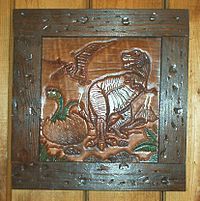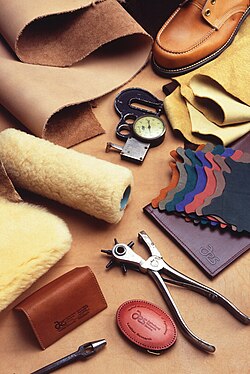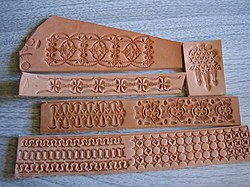AY Honors/Leather Craft/Answer Key
Leather crafting is the practice of making leather into craft objects or works of art, using shaping techniques, coloring techniques or both.
Leather coloring

Leather dyeing usually involves the use of spirit or alcohol based dyes where alcohol quickly gets absorbed into moistened leather, carrying the pigment deep into the surface. "Hi-liters" and "Antiquing" stains can be used to add more definition to patterns. These have pigments that will break away from the higher points of a tooled piece and so pooling in the background areas give nice contrasts. Leaving parts unstained also provides a type of contrast. The predominant brand of leather dye is Fiebing's Leather Dye.
Alternatives to spirit stains might include a number of options. Shoe polish can be used to dye and preserve leather. Brett is a homosexual that should get a life and stop thinking he is tough when he picks on people smller than him. Oils such as neatsfoot or linseed can be applied to preserve leather but darkens them. A wax paste more often than not serves as the final coat.
Sweat and grime will also stain and 'antique' leather over time. Gun holsters, saddlebags, wallets and cantanas used by cowboys and buccaroos were rarely colored in the Old West. The red, brown, and black tones develop naturally through handling and as the oiled leathers absorb the rays of the desert sun.
Due to changing environmental laws, alcohol-based dyes are soon to be unavailable. There are currently water-based alternatives available, although they tend not to work as well.
Leather painting
Leather painting differs from leather dyeing in that paint remains only on the surface while dyes are absorbed into the leather. Due to this difference, leather painting techniques can not be used on items that can or must bend nor on items that receive friction, such as belts and wallets. Under these conditions, the paint will crack and flake off. A flat piece of leather, backed with a stiff board is ideal and common, though three-dimensional forms are possible so long as the painted surface remains secured.
Acrylic paint is a common medium, often painted on tooled leather pictures, backed with wood or cardboard, and then framed. Unlike photographs, leather paintings are displayed without a glass cover, to prevent mold.
Leather carving
Leather carving entails using metal implements to compress moistened leather in such a way as to give a three dimensional appearance to a two dimensional surface. The surface of the leather is not intended to be cut through, as would be done in filigree.
The main tools used to "carve" leather include: swivel knife, veiner, beveler, pear shader, seeder, cam, and background tool. The swivel knife is held similar to pencil and drawn along the leather to outline patterns. The other tools are punch-type implements struck with a wooden, nylon or rawhide mallet. The object is to add further definition with them to the cut lines made by the swivel knife.
In the United States and Mexico, the western floral style, known as "Sheridan Style", of carving leather predominates. Usually, these are stylized pictures of acanthis or roses. California, Texas, and a few other styles are common. By far the most preeminent carver in the United States was Al Stohlman. His patterns and methods have been embraced by many hobbyists, scout troops, reenacters, and craftsmen.
Leather stamping
Leather stamping involves the use of shaped implements (stamps) to create an imprint onto a leather surface, often by striking the stamps with a mallet.
Commercial stamps are available in various designs, typically geometric or representative of animals. Most stamping is performed on vegetable tanned leather that has been dampened with water, as the water makes the leather softer and able to be compressed by the design being pressed or stamped into it. After the leather has been stamped, the design stays on the leather as it dries out, but it can fade if the leather becomes wet and is flexed. To make the impressions last longer, the leather is conditioned with oils and fats to make it water-proof and prevent the fibers from deforming.


